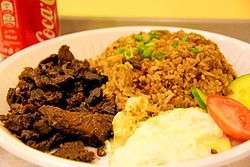Tapa (Filipino cuisine)
|
Beef tapa with garlic fried rice and scrambled eggs | |
| Type | Meat |
|---|---|
| Course | Main course |
| Place of origin | Philippines |
| Main ingredients | Beef, pork, chicken, or fish; salt and spices |
| Variations | dried or cured |
Tapa is dried or cured beef, mutton, venison or horse meat, although other meat or even fish may be used. Filipinos prepare tapa by using thin slices of meat and curing these with salt and spices as a preservation method.
Tapa is often cooked fried or grilled. When served with fried rice and fried egg, it is known as tapsilog (a portmanteau of the Filipino words tapa, sinangag and itlog [egg]). It sometimes comes with atchara (pickled papaya strips) or sliced tomatoes as side dish. Vinegar or ketchup is usually used as a condiment.
Dishes
Before cooking tapa, the meat is cured or dried and cut in to small portions or thin slices. As a method of preservation, salt and spices are added. After preparation, the meat can be cooked either grilled or fried.
Just like any other ulam (main dish) in Filipino cuisine, tapa is usually partnered with rice. It can be garlic rice, java rice, plain rice or any other types of preparation. As a side dish, tapa sometimes comes with atchara (pickled papaya strips) or sliced vegetables (usually tomatoes). Vinegar (oftentimes with siling labuyo) or ketchup is usually used as a condiment.
Tapsilog

Tapsilog is the term used when tapa, garlic-fried rice (sinangag), and fried egg (itlog) are combined into one meal, which is served primarily during breakfast.[1] The word tapa is related to the Sanskrit term tapas which means "heat".[2] In Tagalog, a restaurant that primarily serves tapa is called a tapahan, tapsihan or tapsilugan. According to some sources, tapsilog[3] and tapsihan[4] are colloquial slang words. However, these terms are used by those restaurants and many Filipinos of all social strata. Tapsilog and tapsihan, therefore, may be considered standard words in the Filipino language rather than slang.
Origins
It was originally intended to be quick breakfast fare and the word originally established in 1980's and came from the famous Tapsi ni Vivian restaurant in Marikina City. According to Vivian del Rosario, owner of Tapsi ni Vivian, she was the first to use the term tapsilog.[5]
Related dishes
The word tapsilog has spawned many other dishes, all having fried rice (or garlic fried rice) and fried egg in it and suffixed with silog. Examples are (in alphabetical order):
- Adosilog - adobo, fried rice and fried egg
- Bacsilog - bacon, fried rice and fried egg
- Bangsilog - fried bangus (milkfish), fried rice and fried egg
- Bisteksilog - beef steak, fried rice and fried egg
- Daingsilog - daing, fried rice and fried egg
- Dangsilog - danggit (rabbitfish), fried rice and fried egg
- Chiksilog - fried chicken, fried rice and fried egg
- Chosilog - chorizo, fried rice and fried egg
- Cornsilog - corned beef, fried rice and fried egg
- Hotsilog - hotdog, fried rice and fried egg
- Litsilog - lechon, fried rice and fried egg
- Longsilog - longganisa, fried rice and fried egg
- Masilog or Malingsilog - Ma-Ling brand Chinese luncheon meat, fried rice and fried egg
- Sisilog - sisig, fried rice and fried egg
- SPAMsilog - SPAM brand luncheon meat, fried rice and fried egg
- Tosilog - tocino, fried rice and fried egg
- Vicsilog - vic (chinless hogfish), fried rice and hard-cooked egg yolks
There is a similar dish from Malaysia, the nasi lemak, which is served in a variety of manners using meat, egg and rice with coconut milk.
Restaurants
Small restaurants called tapsihan (or tapsilogan) in many barangays in the Philippines serve tapsilog along with some of its spawns. However, large business establishment chains, such as Sinangag Express, Lola Ely's, Chades, Rodic's, Rufo's Famous Tapa, GoodAh!, Max's, Tapa King, Goto King, and Goto Tapsi Republic, have ventured into selling tapa and the tapsilog. Due to the popularity of this type of cuisine, some fast food chains in the Philippines, including Jollibee, Chowking, McDonald's, and Greenwich Pizza, and even most hotels in the Philippines, have included tapsilog on their breakfast menus.
See also
References
- ↑ Rowthorn, Chris; Greg Bloom; Michael Day (2006). Philippines. Lonely Planet. ISBN 1-74104-289-5. Retrieved 2009-05-31.
- ↑ Harper Fussell, Betty (2008). Raising Steaks: The Life and Times of American Beef. Houghton Mifflin Harcour. p. 332. ISBN 0-15-101202-4. Retrieved 2009-05-31.
- ↑ Define Tapsilog, archived from the original on 2005-02-26, retrieved 2014-04-22
- ↑ Define Tapsilog, archived from the original on 2007-05-04, retrieved 2014-04-22
- ↑ Rodriguez, Jon Carlos (2014-03-01). "Meet the Pinay who started the 'tapsilog' craze". ABS-CBN News. Philippines: ABS-CBN. Retrieved 2014-04-22.
